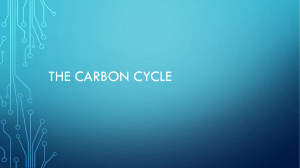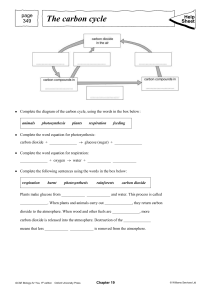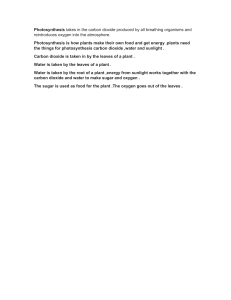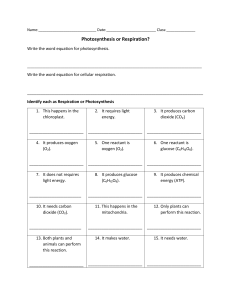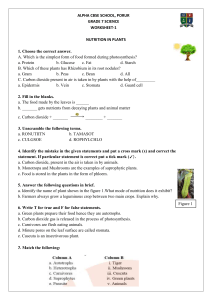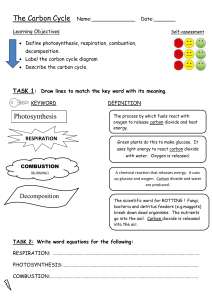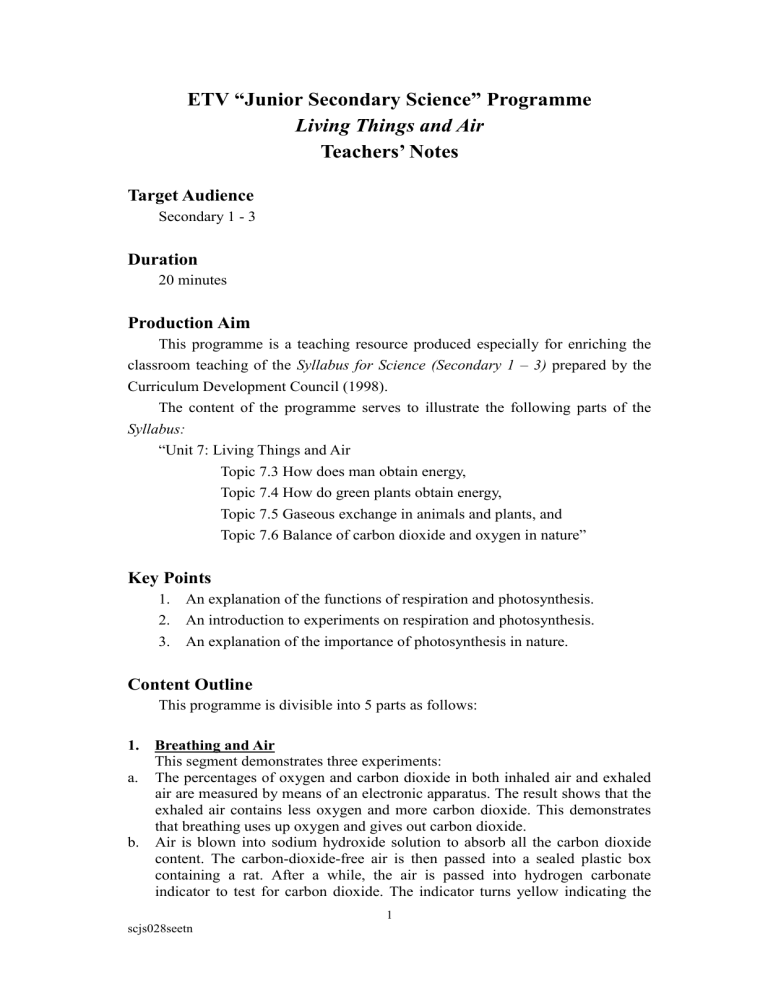
ETV “Junior Secondary Science” Programme Living Things and Air Teachers’ Notes Target Audience Secondary 1 - 3 Duration 20 minutes Production Aim This programme is a teaching resource produced especially for enriching the classroom teaching of the Syllabus for Science (Secondary 1 – 3) prepared by the Curriculum Development Council (1998). The content of the programme serves to illustrate the following parts of the Syllabus: “Unit 7: Living Things and Air Topic 7.3 How does man obtain energy, Topic 7.4 How do green plants obtain energy, Topic 7.5 Gaseous exchange in animals and plants, and Topic 7.6 Balance of carbon dioxide and oxygen in nature” Key Points 1. 2. 3. An explanation of the functions of respiration and photosynthesis. An introduction to experiments on respiration and photosynthesis. An explanation of the importance of photosynthesis in nature. Content Outline This programme is divisible into 5 parts as follows: 1. Breathing and Air This segment demonstrates three experiments: a. The percentages of oxygen and carbon dioxide in both inhaled air and exhaled air are measured by means of an electronic apparatus. The result shows that the exhaled air contains less oxygen and more carbon dioxide. This demonstrates that breathing uses up oxygen and gives out carbon dioxide. b. Air is blown into sodium hydroxide solution to absorb all the carbon dioxide content. The carbon-dioxide-free air is then passed into a sealed plastic box containing a rat. After a while, the air is passed into hydrogen carbonate indicator to test for carbon dioxide. The indicator turns yellow indicating the 1 scjs028seetn c. existence of large amount of carbon dioxide in the air. This demonstrates that when animals breathe, they give out carbon dioxide. Air is blown onto a mirror and the mirror became misty. A piece of blue cobalt chloride paper placed onto the misty area turns pink indicating the substance on the misty area is water. This demonstrates that exhaled air contains water. 2. Respiration of Animals a. b. c. This segment demonstrates another experiments. Two test tubes are connected to both ends of a U-tube via rubber tubings. The two test tubes are then placed into two thermos flasks respectively. One of the flasks contains a rat and the other is kept empty as a control. At the beginning, the water mark inside both tubes lie at the same level, indicating equal air pressure on both sides. Two hours later, the water mark of the test tube in the empty thermos flask rises while the other lowers showing that air pressure of the test tube in the thermos flask with the rat has increased. This is probably due to a rise in temperature in the flask, causing air in the test tube to expand. This demonstrates that heat energy is released when the rat breathes. An explanation of respiration follows. Breathing brings oxygen into the body of a living thing. Oxygen is eventually brought into the cells. Chemical reactions between oxygen and the food stored in the cells occur, releasing energy and carbon dioxide. The energy is immediately used in metabolism. This process is called respiration. A piece of butter is burnt to heat up a small amount of water. During the burning process a gas which turned lime water milky is released showing that the gas was carbon dioxide. This demonstrates that burning and respiration are similar in the way that both of them consume oxygen and give out energy and carbon dioxide. 3. Respiration of Plants This segment demonstrates three experiments: a. Air is blown into sodium hydroxide solution to absorb all the carbon dioxide content. The carbon-dioxide-free air is then passed into a sealed plastic box containing a living green plant. The plastic box is covered up by a black box to stop photosynthesis. After a while, the air is then passed into hydrogen carbonate indicator to test for carbon dioxide. The indicator turns yellow indicating the existence of large amount of carbon dioxide in the air. This demonstrates that when plants respire, they give out carbon dioxide. b. A capillary tube with a drop of red ink is inserted into a test tube containing sodium hydroxide pellets and some germinating seeds. Another set-up is assembled using boiled dead seeds as control. After a while, the red ink of the set-up using germinating seeds drops indicating a decrease in the amount of air inside the test tube. Meanwhile the ink drop in the control shows no change in position. This demonstrates that plants respire to consume oxygen. c. A thermometer is inserted into a thermos flask containing germinating seeds. The thermos flask is then sealed and placed upside down. Another set-up is assembled using dead seeds as control. After one day, an increase in temperature for the flask containing germinating seeds is recorded while there is no change in temperature for the control. This demonstrates that when plants respire, they give out energy. 2 scjs028seetn 4. a. b. Photosynthesis This segment demonstrates two experiments on photosynthesis: Green water weed is placed under light and bubbles of gas produce. The bubbles are collected in a test tube and tested by a glowing splint. The glowing splint relights showing that the gas is oxygen. This demonstrates that plants undergo photosynthesis to give out oxygen. A green plant is placed in a dark chamber for several days so as to eliminate the product of photosynthesis in the leaves. The plant is then taken out, and a part of a leaf is covered with a piece of aluminum foil. The plant is then placed under light for several hours to carry out photosynthesis. The leaf is then removed and tested for starch using iodine solution. The uncovered part of the leaf turns dark blue while the covered part shows the colour of the iodine solution. This demonstrates that plants undergo photosynthesis to produce starch. 5. The importance of photosynthesis a. In nature, living things get their food from other animals or plants. For example, vegetables in our meals come from plants, whereas beef and other meat come from animals. However, cows feed on grass. Hence, people who eat beef indirectly rely on plants. This example shows that, while a cow eats grass, a man eats beef, which is the flesh of a cow. The energy fixed by grass through photosynthesis is passed to the cow, the energy stored in the cow is eventually passed to the man. This pathway of energy transfer is called the "food chain". Animals breathe all the time, taking in the oxygen in air and releasing carbon dioxide. Plants also respire all the time, consuming the oxygen in air and releasing carbon dioxide. Burning also consumes oxygen and releases carbon dioxide. However, the relative amount of oxygen and carbon dioxide in air would not change. The reason is that green plants under sunlight undergo photosynthesis while respiring, hence they consume the carbon dioxide in air and release oxygen in return. b. Suggestions for Utilization The teacher is advised to show the programme in one lesson. The teacher may spend 5 to 10 minutes at the beginning of each lesson to lead students to discuss with reference to the Preparation before viewing the programme part of the Suggested Activities. The teacher may then show the programme. After the show, the teacher may spend another 10 to 15 minutes to discuss with students with a view to consolidating the concepts and methods illustrated in the programme. The teacher is advised to refer to the Activities after viewing the programme part of Suggested Activities. Suggested Activities (The following activities are suggested for teacher’s reference only. The teacher may wish to use the activities according to students’ abilities, the learning environment of the class, and the teaching time available.) 3 scjs028seetn Preparation before viewing the programme 1. The teacher may ask students the following questions on living things and air and let them think before watching the programme: a. Where will oxygen go after being taken in the human body? b. Why does a man breathe more rapidly during and after an exercise? c. As animals breathe to take in oxygen and release carbon dioxide, will this lead to increasing amount of carbon dioxide in air? 2. The teacher may then invite students to watch the programme carefully and find out the answers themselves. Activities after viewing the programme 1. The teacher may instruct students to carry out various experiments in the programme so as to enhance their understanding on respiration and photosynthesis. (Precaution: When conducting the experiment on burning butter, the teacher should ensure that it is carried out in a well-ventilated area since it will produce a rather fierce flame.) The teacher may also choose other kind of food to carry out the experiment and compare the energy provided by different kinds of food. 2. The teacher may ask students to record the menu for a certain meal and try to draw the food chain on the sources of the related food. 4 scjs028seetn
